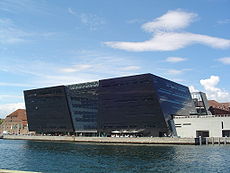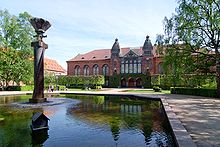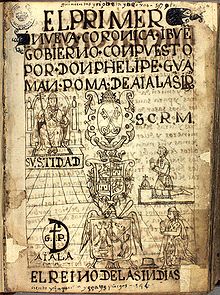- Royal Danish Library
-
Det Kongelige Bibliotek, Danmarks Nationalbibliotek og Københavns Universitetsbibliotek English The Royal Library, The National Library of Denmark and Copenhagen University Library 

The Black Diamond building, viewed from the south-east Country  Denmark
DenmarkType National Library, University Library Scope Danish Museum of Books and Printing, The National Museum of Photography, Museum of Danish Cartoon Art. - Main library for The University of Copenhagen Established 1648 (University Library founded 1482) Reference to legal mandate No special law. The obligations of the library are stated in the annual Financial State Budget Location Copenhagen Branches 3 (all in Copenhagen): Faculty Library of Humanities (Amager), Faculty Library of Natural and Health Sciences (Nørre Alle), Faculty Library of Social Sciences (Gothersgade) Collection Items collected Books, journals, newspapers, pamphlets and corporate publications, manuscripts and archives, maps, prints and photographs, music scores, documentation of folkways and popular traditions, four annual electronic copies of the Danish Internet Size 6,000,000 books and journals, 17,900,000 prints and photographs, 7,300,000 pamphlets and corporate publications, 1,200,000 other materials (32,400,000 total items)[1] Legal deposit Since 1697 Access and use Access requirements Open to anyone above the age of 18 with a genuine need to use the collections. Special rules apply for use of rare and valuable items. Circulation 7,000,000 loans (6,400,000 of these are electronic loans) Members 37,100 active users Other information Budget 337M Danish Kroner (64M US Dollars) Director Mr. Erland Kolding Nielsen, director general (since 1986) Staff 593 persons, 426 Full-time equivalent Website http://www.kb.dk/en/index.html Phone number +45 3347474747 The Royal Library in Copenhagen (Det Kongelige Bibliotek) is the national library of Denmark and university library of University of Copenhagen. It is the largest library in the Nordic countries.[2]
It contains numerous historical treasures; all works that have been printed in Denmark since the 17th century are deposited there. Thanks to extensive donations in the past the library holds nearly all known Danish printed works back to the first Danish book, printed in 1482.
Contents
History
The library was founded 1648 by King Frederik III who seeded it with a comprehensive collection of European works. It was opened to the public in 1793. In 1989 it was merged with the prestigious University Library (founded 1482) (UB1) and in 2005 it was merged with the Danish National Library for Science and Medicine (UB2), now the Faculty Library of Natural and Health Sciences). The official name of the organization as of 1 January 2006 is The Royal Library, the National Library of Denmark and Copenhagen University Library. In 2008 the Danish Folklore Archive was merged with The Royal Library.
The Royal Library today
Today it has four sites: one at Gothersgade, central Copenhagen, specializing in the social sciences and law, one at Amager specializing in the humanities, one at Nørre Alle specializing in the Natural and Health Sciences, and the main library at Slotsholmen, Copenhagen harbour, covering all subjects and special collections.
Old building
The old building of the Slotsholmen site was built in 1906 by Hans Jørgen Holm. The central hall is a copy of Charlemagne's Palace chapel in the Aachen Cathedral.
Black Diamond
Main article: Black Diamond (library)In 1999, a new building adjacent to the old one was opened at Slotsholmen, known as the Black Diamond. The Black Diamond building was designed by Danish architects schmidt hammer lassen. Named for its outside cover of black marble and glass, it houses a concert hall in addition to the library. (Location: 55°40′25.5″N 12°34′55″E / 55.67375°N 12.58194°E.)
This new building was opened 1999. It is formed by two black cubes that are slightly tilted over the street. In the middle of them there is an eight storey atrium whose walls are white and wave-shaped, with a couple of transversal corridors that link both sides, and balconies in every store. The atrium's exterior wall is made of glass, so you can see the sea and, in the other shore, Christianshavn's luxury buildings. Three bridges connect the Black Diamond with the old part of the Royal Library; those three bridges (two small ones for internal transport and a big one with the circulation desk) go over the road. In the ceilling of the big bridge there is a huge painting by Danish painter Per Kirkeby.
Significant collections
The holdings include a 2000-item collection of books by and about Carl Linné, which was inscribed on UNESCO's Memory of the World Register in 1997 in recognition of its historical significance.[3]
Other treasures include the Arnamagnæan Manuscript Collection; the manuscripts and correspondence of Hans Christian Andersen; the Søren Kierkegaard Archives (manuscripts and personal papers); the Dalby Book (a Latin Gospel on parchment), the Angers fragment (parts of Denmark's first national chronicle) and maps of the Polar Region, which were also inscribed on the Memory of the World Register in 1997 as the "Treasures from the Royal Library."[4]
Guamán Poma de Ayala's El Primer Nueva Coronica y Buen Gobierno, an autographed manuscript of 1,200 pages including 400 full-page drawings depicting the indigenous point of view on pre-conquest Andean life and Inca rule, the Spanish conquest in 1532, early Spanish colonial rule, and the systematic abuse of the rights of the indigenous population, is also among the holdings and was also inscribed on the Memory of the World Register in 2007.[5]
Book theft
Between 1968 and 1978, the library saw one of the largest book thefts in history. Someone had managed to steal some 1,600 historical books worth more than $50 million, including prints by Martin Luther and first editions by Immanuel Kant, Thomas More and John Milton. The theft remained undetected until 1975. Between 1998 and 2002, the thief succeeded in selling books worth some $2 million at various auctions. The case was finally solved in September 2003, after a stolen book had surfaced at Christie's auction house in London. The thief, a head of department of the library's oriental department named Frede Møller-Kristensen, had died in February 2003. His family then became careless in selling the remaining books. At a coordinated raid of the family's homes in Germany and Denmark in November 2003, some 1,500 books were recovered. In June 2004, his wife, son, daughter-in-law and a family friend were sentenced to prison terms ranging from 18 months to 3 years; the friend was acquitted on appeal. In April 2005, a daughter of the thief was also found guilty.
Librarians
The first librarian was Peder Griffenfeld. Daniel Gotthilf Moldenhawer was notorious for stealing numerous books to enrich the library collections. Later librarians included J. H. Schlegel, Jon Erichsen, Chr. Bruun and Hans J. Holm.
See also
- Royal Library Garden, Copenhagen
References
- ^ All figures in the box are from: Årsberetning 2010 (Annual Report 2010) [1] (Danish)
- ^ Den store danske: Det kongelige bibliotek (Danish)
- ^ "The Linné Collection". UNESCO Memory of the World Programme. 2008-05-16. http://portal.unesco.org/ci/en/ev.php-URL_ID=22884&URL_DO=DO_TOPIC&URL_SECTION=201.html. Retrieved 2009-12-11.
- ^ "Manuscripts and correspondence of Hans Christian Andersen". UNESCO Memory of the World Programme. 2008-05-16. http://portal.unesco.org/ci/en/ev.php-URL_ID=22664&URL_DO=DO_TOPIC&URL_SECTION=201.html. Retrieved 2009-12-15.
- ^ "El Primer Nueva Coronica y Buen Gobierno". UNESCO Memory of the World Programme. 2008-05-16. http://portal.unesco.org/ci/en/ev.php-URL_ID=22485&URL_DO=DO_TOPIC&URL_SECTION=201.html. Retrieved 2009-12-15.
External links
- English home page of the library
- The Danish Digital National Library
- Cultural activities of the Black Diamond
- The European Library - Combined access to 48 national libraries in Europe
- Bibliotek.dk - Danish Internet portal for all Danish libraries
- (English) List of missing books
- (Danish) Report on the theft (pdf)
National libraries of Europe Sovereign
states- Albania
- Andorra
- Armenia
- Austria
- Azerbaijan
- Belarus
- Belgium
- Bosnia and Herzegovina
- Bulgaria
- Croatia
- Cyprus
- Czech Republic
- Denmark
- Estonia
- Finland
- France
- Georgia
- Germany
- Greece
- Hungary
- Iceland
- Ireland
- Italy
- Kazakhstan
- Latvia
- Liechtenstein
- Lithuania
- Luxembourg
- Macedonia
- Malta
- Moldova
- Monaco
- Montenegro
- Netherlands
- Norway
- Poland
- Portugal
- Romania
- Russia
- San Marino
- Serbia
- Slovakia
- Slovenia
- Spain
- Sweden
- Switzerland
- Turkey
- Ukraine
- United Kingdom
- (England
- Northern Ireland
- Scotland
- Wales)
States with limited
recognition- Abkhazia
- Kosovo
- Nagorno-Karabakh
- Northern Cyprus
- South Ossetia
- Transnistria
Dependencies
and other territories- Åland
- Faroe Islands
- Gibraltar
- Guernsey
- Jan Mayen
- Jersey
- Isle of Man
- Svalbard
Other entities Categories:- National libraries
- Libraries in Copenhagen
- Individual thefts
- Culture in Copenhagen
- Education in Copenhagen
- 1640s establishments
- Royal Danish Library
Wikimedia Foundation. 2010.


